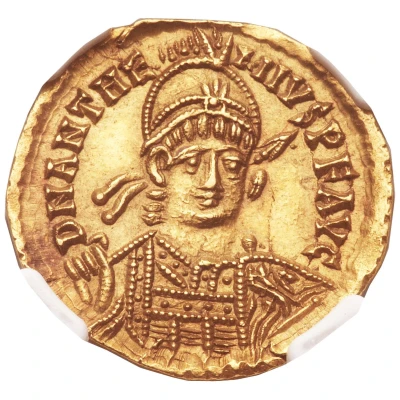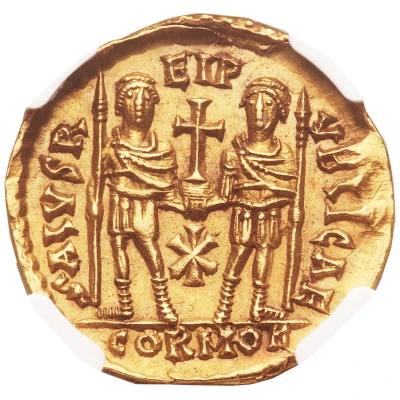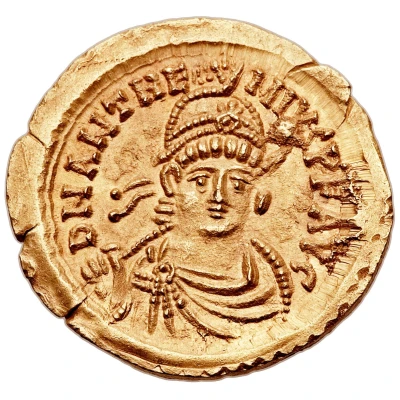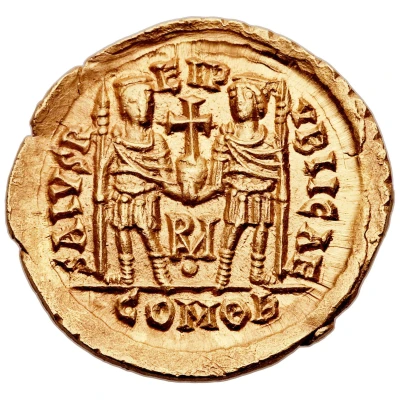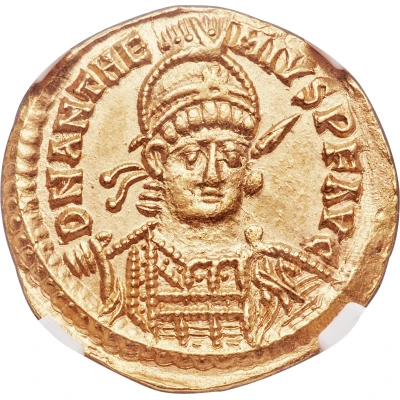
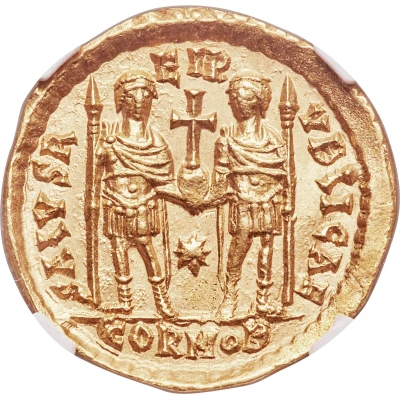

© Heritage Auctions
Solidus - Anthemius SALVS REI PVBLICAE; Rome
| Gold | 4.41 g | 21 mm |
| Issuer | Western Roman Empire (Rome) |
|---|---|
| Emperor | Anthemius (467-472) |
| Type | Standard circulation coin |
| Years | 467-472 |
| Value | 1 Solidus |
| Currency | Solidus |
| Composition | Gold |
| Weight | 4.41 g |
| Diameter | 21 mm |
| Shape | Round (irregular) |
| Technique | Hammered |
| Orientation | Variable alignment ↺ |
| Demonetized | Yes |
| Updated | 2024-10-04 |
| Numista | N#373726 |
|---|---|
| Rarity index | 97% |
Reverse
Anthemius and Leo I standing facing in military dress, each holding spear in outer hand, jointly holding globus cruciger between them; star in central field, mintmark in exergue.
Script: Latin
Lettering:
SALVS R-EI P-VBLICAE
CORMOB
Comment
The short, troubled reign of Procopius Anthemius represents the Roman world's last chance at unity in the face of the disasters that would shortly overwhelm its western half. Born into a distinguished and wealthy Constantinopolitan family, Anthemius was highly regarded as a general and magistrate, and had been considered a prime candidate for the East Roman throne when his father-in-law, the emperor Marcian, died in AD 457. Instead, Leo I got the job, but Anthemius took the setback in stride and won a series of military victories over the Goths and Huns on Leo's behalf. In the mid AD 460s, Vandal raids on Greece convinced Leo that he needed to cooperate with the West Roman regime headed by the half-barbarian generalissimo Ricimer. In AD 467, with Ricimer's approval, Leo appointed Anthemius to the vacant western throne. Anthemius reached Rome on April 12 and was duly hailed as Augustus by the Senate, but many Italians viewed him as a Greek interloper and this colored his relations with the locals from the outset. In AD 468, a massive joint naval expedition against the Vandals in North Africa came to grief, badly undermining Anthemius' position. Visigothic gains in Gaul further eroded his popularity over the next few years and caused a dangerous rift to develop between Anthemius, who ruled from Rome, and Ricimer, based in Milan. Leo tried to mediate by sending a highborn envoy named Olybrius to Italy in the spring of AD 472, but Ricimer decided Olybrius would prove a more pliable puppet emperor and marched against Rome to depose Anthemius. Rome underwent a three-month siege and finally fell to a determined attack on the Pons Aelius. Anthemius donned the garb of a beggar and tried to escape, but was identified, captured and beheaded, probably on July 11, AD 472. Olybrius replaced him but survived only a few months before dying of dropsy. The brief, disastrous civil war made a final split with the East inevitable and sealed the doom of West Roman Empire. The gold coinage of Anthemius reflects his origins by following the convention for frontal portraiture found on East Roman and later Byzantine coins. The reverse of this incredible Rome-mint gold solidus celebrates the supposed unity of East and West empires by showing Anthemius and Leo together supporting a long cross, on which rests, according to the legend, the "Health of the Republic."Interesting fact
One interesting fact about the Solidus - Anthemius coin is that it features the first known use of the Christian chi-rho monogram on a Roman coin. The chi-rho monogram, which is a combination of the first two letters of the Greek word for Christ (chi and rho), was a symbol of Christianity that was later adopted as the official symbol of the Roman Empire under Emperor Constantine. The inclusion of this symbol on the coin suggests that Anthemius, the Emperor who issued the coin, may have been a Christian or had sympathies towards the Christian faith. This is significant because it indicates that Christianity was gaining acceptance and influence in the Roman Empire during this time period.
